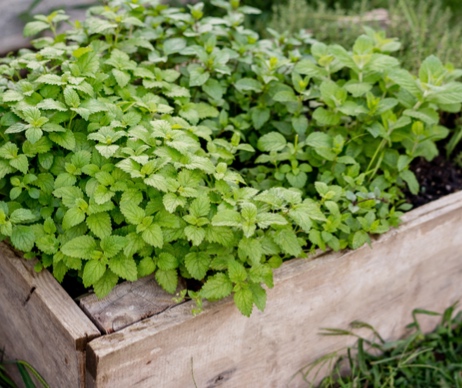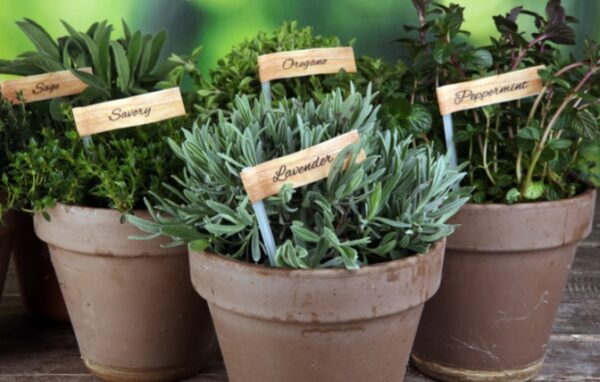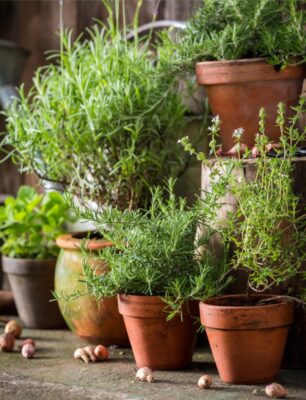by Ann Cipperly
While growing up on her grandparents’ farm in Chamber County, Tia Gonzalez developed an interest in plats and gardening. She graduated from Auburn University in ornamental horticulture and assisted with the university’s medicinal plant garden until it was removed in construction of the Gauge Performing Arts Center. Once the new Transformation Gardens are completed, she will work in the herb section. Meanwhile, she is enjoying working in horticulture and is sharing tips for growing herbs.
 On the second Saturday every month, Tia volunteers at the herb garden at the Lee County Historical Museum. Peggy Mitchell planted the garden and is the main caretaker, while Tia volunteers. She is available at the herb garden to answer questions about herbs for visitors.
On the second Saturday every month, Tia volunteers at the herb garden at the Lee County Historical Museum. Peggy Mitchell planted the garden and is the main caretaker, while Tia volunteers. She is available at the herb garden to answer questions about herbs for visitors.
“Herbs are valued for their flavor, fragrance, medicinal and healthful qualities, pesticidal properties and coloring materials,” says Tia. “Culinary herbs are distinguished from vegetables like spices, as they are used in small amounts and provide flavor rather than substance to food.”
Growing herbs in pots is the easiest way to get started. “Some herbs perform better in pots than in the garden,” Tia says. “Use good quality, well-drained potting mix in the pots. FoxFarm is my favorite.”
She suggests getting appropriately sized pots. “Clay pots breathe better, but the soil will dry faster, while plastic pots hold moisture better,” she adds. “When watering, be sure to water the roots and avoid getting leaves wet. Soak roots thoroughly and allow the soil to get moderately dry before watering again. As the plant gets larger, move it to a larger pot.”
For herbs that prefer less humidity, such as thyme, sage and lavender, Tia recommends adding mulch to the soil surface with one to two inches of gravel.
While some common culinary herbs are difficult to grow in the humid South, others grow well. Perennial herbs will live from year to year, but annual herbs only live one season. “You can slow the process by removing flowers before they set seed,” Tia suggests. “Allow flowers to set seed late in the season, then collect the seeds or allow self-sowing into the garden.”
Here is a list of herbs Tia recommends to plant for our area.
Rosemary is an evergreen and grows in pots or gar-dens. After a while the plant will get too large for a pot. During winter, the pot will need protection if the temperature drops below 25 degrees. Tia recommends “Tuscan Blue” rosemary and to trim it regularly, cutting no more than a third of the length of a branch.
Oregano plants should be chosen for their smell and taste. “Italian oregano has the most familiar flavor,” Tia says. “Greek oregano is very spicy. The flowering tops have the best flavor, but the leaves are delicious too. Harvest the herb regularly to maintain good health of the plant. It is easy in pots or in well-drained garden soil.”
 Chives and garlic chives are easy to start from seed or division and grow in pots or the garden with full sun. The flowers are edible and should be removed quickly before they seed on the garlic chives, which will reseed quickly. To harvest chives, cut leaves at the base of the plant.
Chives and garlic chives are easy to start from seed or division and grow in pots or the garden with full sun. The flowers are edible and should be removed quickly before they seed on the garlic chives, which will reseed quickly. To harvest chives, cut leaves at the base of the plant.
Mint is easy to grow and does well in part shade or sun if watered often. “Mint will spread so vigorously that most folks keep them in pots,” Tia says. “Cut the mint back frequently to maintain a tidy plant. Overgrown plants can be cut back to soil level. Spearmints that have a dark stem usually have superior flavor.”
Lemon Balm grows in full sun or part shade and prefers consistent soil moisture. The plant will reseed abundantly.
Thyme is an evergreen perennial but needs good drainage and dislikes high humidity. It will grow well in clay pots in well-drained soil with fine gravel in the potting soil. Choose a variety with a smooth leaf but don’t water the leaves.
Texas Tarragon, also known as Mexican Mint Marigold, has a robust flavor and is a native of Central America. It grows well in hot humid weather with full sun. “Frost will kill the top, but the roots will survive, depending on the severity of the winter,” says Tia. “Foliage will re-emerge as the soil warms in late spring. Texas tarragon has lovely yellow flowers in the late summer and early fall. The flowers are edible and make lovely garnishes.”
Sweet basil prefers hot, humid weather and even moisture with full sun to provide the best flavor. Keep the tips pinched to maintain healthy plants. Remove flowers to encourage better growth. “Basil cannot endure frost,” Tia says. “Potted plants can be brought in for the winter but must be given plenty of sunlight and supplemental light to imitate the long days of summer.”
Cilantro grows in the fall, and mature plants can endure frost. When nights get warm, cilantro will go to seed “You will first notice ferny foliage forming,” explains Tia, “and then a flower stalk will emerge from the center of the plant. Allow the flowers to form, as they will give way to seeds that are coriander.
“When the seeds turn brown and begin to drop off easily, harvest them by putting a paper bag over the seed head. Clip off the seed head, close the bag and shake vigorously. You will have a bag of coriander. The flavor seed is not interchangeable with the leaves of cilantro.”
Dill needs cool, not hot weather. It is a caterpillar host.
 Parsley is a biennial that takes two seasons to grow, make flowers and set seeds, then the plant dies. It prefers cooler weather, so light summer shade is ideal and full sun in the winter. Flat-leafed parsley is preferred by most cooks. “Curly parsley is used for garnish and as a winter bedding plant,” says Tia. “Flat-leafed parsley looks very similar to cilantro. Smell the leaf to distinguish between the two.”
Parsley is a biennial that takes two seasons to grow, make flowers and set seeds, then the plant dies. It prefers cooler weather, so light summer shade is ideal and full sun in the winter. Flat-leafed parsley is preferred by most cooks. “Curly parsley is used for garnish and as a winter bedding plant,” says Tia. “Flat-leafed parsley looks very similar to cilantro. Smell the leaf to distinguish between the two.”
Tia’s suggestions for growing herbs in a garden are the same as other plants. These include taking care of the soil, selecting the correct area depending on if it needs sun, shade or part shade, and if it will grow in our zone, which is number eight. She recommends getting soil in the garden tested. Herbs need a well-drained soil and generally four to six hours of sun a day.
Many herbs are perfect additions to existing vegetable gardens. Basil and tomatoes are good companions. Cilantro, parsley and fennel work well with lettuce, collards and turnips.
The 16-acre Transformation Garden will be a research and teaching garden, including vegetables, fruits, ornamentals, container gardening, row crops and much more. Students will receive training in hydroponic and urban farming. Research will focus on irrigation and technologies, fruit, vegetable gardening, medicinal plants, among others. It will be designated as a Green Corridor.
Once the new Transformation Gardens are completed, plan to take a tour, and be sure to visit the new herb garden for more ideas on growing herbs at home.
To contact Tia Gonzalez, email her at [email protected].







